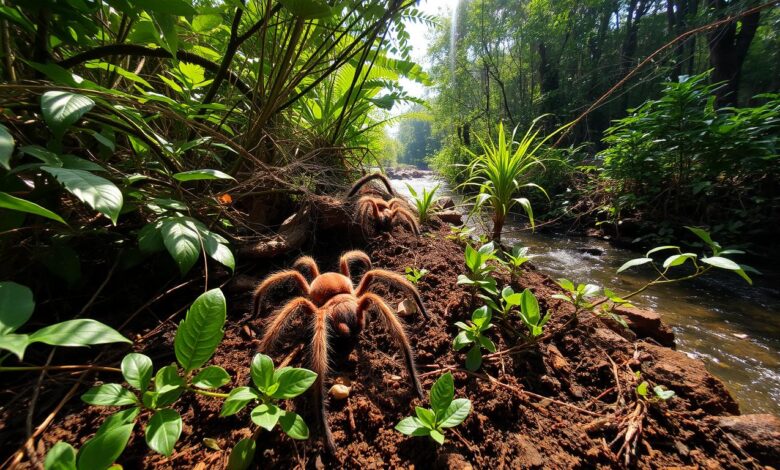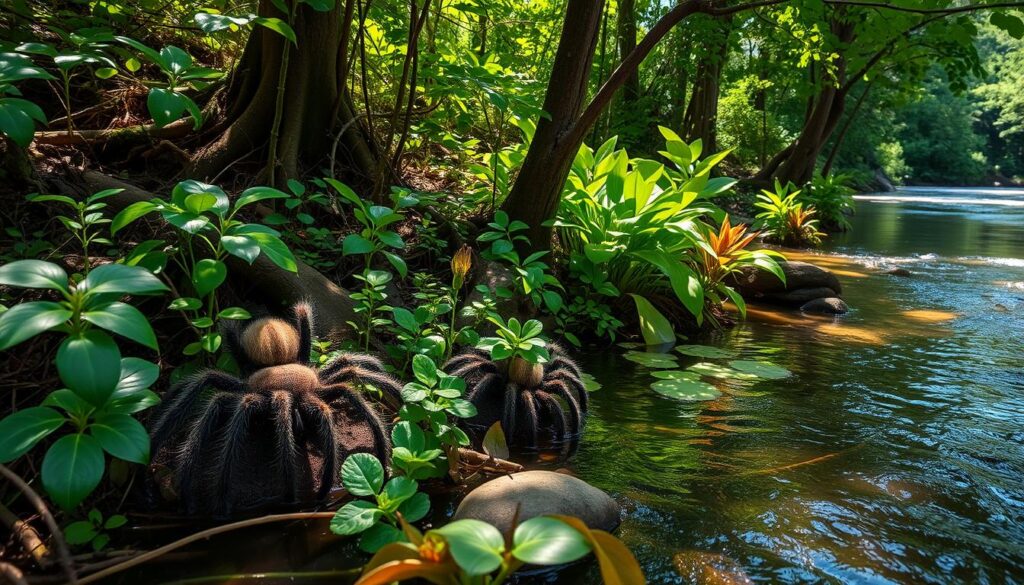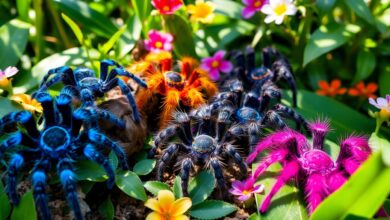Importance of watersheds as habitat for tarantulas

Have you ever thought about how crucial watersheds are for tarantulas? These spiders live in riparian ecosystems and show how diverse life thrives in the world’s biggest drainage basins. By looking into the importance of watersheds as habitat, we learn about the deep connections in nature and how these creatures live in balance.
The Amazon basin covers 34% of South America and is home to over 10% of the world’s life forms. This includes more than 40,000 plant species, 1,300 bird species, and millions of insects and other invertebrates. Tarantulas live here, in a complex ecosystem that depends on the watershed. By studying their relationship with their habitats, we can learn how to protect these ecosystems.
Tarantulas in Catchments: Overlooked Inhabitants of Riparian Ecosystems
The Amazon basin is famous for its vast rainforests and wetlands. It also has many tarantulas, which are key to the health of riparian ecosystems. These spiders help keep the balance in catchment areas. Knowing where and how tarantulas live is crucial for protecting environmental conservation and biodiversity monitoring.
Riparian communities depend a lot on aquatic-derived subsidies. Spiders, including tarantulas, thrive where there are many emergent aquatic insects. In fact, some spiders get almost all their food from aquatic-derived organic matter. This shows how important tarantulas are in watershed management systems.
| Key Statistic | Value |
|---|---|
| Riparian spiders rich in EPA, reflecting Σω3/Σω6 ratio comparable to aquatic organisms | – |
| Emergent aquatic insect consumption by spiders highest in spring | – |
| Riparian lizards without access to aquatic insects show reduced growth rates | – |
| Low amounts of aquatic-derived subsidies linked with reduced immune function in riparian spiders | – |
Studying species distribution and biogeography of tarantulas helps us understand riparian ecosystems better. Invertebrate surveys and biodiversity monitoring can spot threats early. This info helps make plans to protect these vital arachnid habitats.

Watershed Biodiversity: The Vital Role of Tarantulas
Tarantulas are key to the health of watershed ecosystems. They help keep the balance of other invertebrates, which is vital for the food web in riparian areas.
Tarantulas as Indicators of Environmental Health
Researchers use tarantulas to check on the health of watersheds. They look at how many tarantulas there are to see how human actions like deforestation and pollution affect these ecosystems. Tarantulas are very sensitive to changes in their arachnid habitats. This makes them great indicators of environmental conservation and biodiversity monitoring in watersheds.
Predator-Prey Dynamics in Riverine Habitats
Tarantulas are predators in riparian ecosystems. They help control the numbers of other invertebrates. Their numbers tell us a lot about the spider ecology and species distribution in watershed management areas. By studying these predator-prey dynamics, researchers can keep an eye on the health and biodiversity of the catchment area.

Tarantulas are important signs of the environmental health and biodiversity in watershed ecosystems. By watching these arachnids, researchers can learn a lot about the balance of these important riparian habitats. They can also see how human actions affect invertebrate surveys and biogeography studies in the watershed.
Tarantula Biogeography: Mapping Species Distribution in Watersheds
Understanding tarantulas in watershed regions is key for protecting the environment. By mapping where different tarantula species live, researchers can find areas rich in biodiversity. This helps them track population changes and protect these spiders and their homes.
Surveys of tarantulas in riparian ecosystems give us insights into their lives. Scientists use invertebrate surveys and biogeography studies to see where tarantulas live and how they connect with their environments. This info helps protect these spiders and keep track of their spider ecology.
Researchers map tarantula species across catchment areas to find diversity hotspots. This helps them focus conservation efforts. It also leads to the creation of protected areas and sustainable watershed practices. These actions help protect tarantulas and their riparian ecosystems.
Using biogeographic data on tarantulas helps us understand ecosystems better. It shows how these spiders act as indicators of environmental health. By tracking tarantulas, scientists learn about the health of the watershed. This info guides conservation and watershed management.
Threats to Tarantula Populations in Catchment Areas
Tarantulas live in riparian ecosystems and face many threats. Habitat loss and deforestation are big worries. So are water pollution and harmful substances.
Habitat Fragmentation and Deforestation
Humans clearing land for farms or cities harms riparian ecosystems. This breaks up tarantula homes. It makes it hard for them to find mates and have babies. Deforestation is especially bad since tarantulas need forests for shelter and food.
Water Pollution and Environmental Contaminants
Pollutants like pesticides hurt tarantulas and other creatures in catchment areas. These substances mess with the watershed ecosystem. They can reduce food and harm tarantulas.
We need to act to save tarantulas and protect watershed ecosystems. This means using land wisely and controlling pollution.
| Threat | Impact on Tarantula Populations | Potential Mitigation Strategies |
|---|---|---|
| Habitat Fragmentation and Deforestation | Loss of critical habitats, isolation of populations, disruption of breeding and feeding grounds | Establishment of protected areas, implementation of riparian buffer zones, sustainable forestry practices |
| Water Pollution and Environmental Contaminants | Disruption of food webs, direct toxicity to tarantulas, degradation of overall ecosystem health | Stricter regulations on industrial and agricultural waste management, deployment of water treatment technologies, promotion of organic farming |
Conservation Strategies for Tarantulas in Watershed Ecosystems
Protecting tarantulas in watershed areas means keeping their homes safe. We can do this by setting up protected areas like national parks. These places help keep tarantulas and other animals safe. Also, making riparian buffer zones along rivers helps reduce harm from human activities.
Protected Areas and Riparian Buffer Zones
These conservation steps help tarantulas and their homes last a long time. Protected areas are safe spots for tarantulas to live and have babies. Riparian buffer zones protect these areas from pollution and other human damage.
By setting up protected areas and riparian zones, we can save tarantulas and many other species. Keeping their homes safe helps keep the balance in these important ecosystems.
| Conservation Measure | Benefits for Tarantulas | Ecosystem Impacts |
|---|---|---|
| Protected Areas | Safeguards tarantula populations and habitats | Preserves overall biodiversity in watersheds |
| Riparian Buffer Zones | Mitigates human-induced disturbances to tarantula habitats | Maintains the health and integrity of riparian ecosystems |
Invertebrate Surveys: Monitoring Tarantula Populations in Catchments
It’s key to watch the numbers of tarantulas and other invertebrates in watershed areas. This helps us understand how healthy these ecosystems are and how diverse they are. By doing invertebrate surveys, scientists can see how many tarantulas there are, find new kinds, and learn about where they live and how they live. This info is super important for conservation efforts and helping us manage watershed environments so tarantulas and other species can keep living there.
These surveys look closely at the spider ecology in these riparian ecosystems. They’ve found that more bugs coming out of the water means more spiders in the area. This shows how important these arachnid habitats are for keeping an eye on biodiversity in watershed systems.
By seeing where tarantulas and other invertebrates live, scientists can learn a lot about their biogeography and what they need for environmental conservation. This helps us make better plans for watershed management. It’s all about keeping these riparian ecosystems safe for the long run.
| Metric | Findings |
|---|---|
| Reliance on Aquatically Derived Energy (ADE) | Positive correlation between emergent aquatic insect biomass/emergence rate and riparian spider biomass/web density |
| Trophic Position (TP) | Associations between urban stream characteristics and hydrogeomorphic conditions |
| Emergent Insect Flux | Impact of flow regime on aquatic-to-terrestrial subsidies, with low flows leading to decreased biomass of emergent aquatic insects and riparian spiders |
By doing invertebrate surveys in catchment areas, researchers get important data. This data helps us protect tarantula populations and the watershed ecosystems they live in. This research is key for keeping these special arachnid habitats safe and supporting the biodiversity they have.
Watershed Management and Tarantula Habitat Preservation
Managing watersheds well is key to keeping tarantula habitats safe and healthy. This means using sustainable forestry and agricultural practices that don’t harm arachnid habitats.
Sustainable Forestry and Agricultural Practices
Using selective logging and keeping buffer zones by water helps protect tarantula populations. It also keeps the biodiversity of watershed regions safe. Working together, researchers, policymakers, and local people can make these conservation-minded approaches work in watershed management.
| Conservation Measure | Impact on Tarantulas |
|---|---|
| Selective Logging | Preserves essential arachnid habitats within riparian ecosystems |
| Riparian Buffer Zones | Protects tarantula populations and biodiversity monitoring in watershed areas |
| Integrated Pest Management | Minimizes the use of harmful chemicals, safeguarding spider ecology and invertebrate surveys |
By using these sustainable methods, land managers can keep the balance right in tarantula habitats within watershed ecosystems. This helps protect these amazing arachnids and the biodiversity of these important catchment areas.
Tarantula Ecology: Adaptations to Riverine Environments
The dynamic environments of watershed ecosystems have shaped the remarkable adaptations of tarantulas. These arachnid habitats within riparian ecosystems have led to the development of specialized features. These features help these creatures thrive in seasonal floods, changing water levels, and other environmental challenges.
Tarantulas have water-repellent setae, or tiny hairs, on their legs. These help them move in damp, often flooded areas of watershed management areas. These hairs provide traction and prevent the arachnids from getting waterlogged. This lets them move quickly across water or crawl to higher ground when water is high.
Another key adaptation is their ability to burrow deep into the soil. They create intricate underground tunnels and nesting chambers. This behavior offers shelter from the elements and lets them escape rising waters during environmental stress. By burrowing, they can regulate their body temperature, conserve moisture, and avoid predators. This ensures their survival in the dynamic riverine environments.
Understanding the unique adaptations of tarantulas in catchment areas is vital for effective conservation strategies. It helps protect these captivating invertebrate surveys within watershed ecosystems. By studying the biogeography and specialized traits of these arachnids, researchers can better protect and manage their species distribution within riparian habitats. This contributes to the overall environmental conservation of these vital biodiversity monitoring zones.
| Adaptation | Description | Benefit |
|---|---|---|
| Water-repellent setae | Specialized, water-resistant hairs on the legs | Enables movement across water and protection from waterlogging |
| Burrowing behavior | Ability to construct intricate underground tunnels and nesting chambers | Provides shelter, temperature regulation, moisture conservation, and predator avoidance |
By understanding the remarkable adaptations of tarantulas to riverine environments, we can better protect and manage these invertebrate populations. This ensures the long-term health and resilience of watershed ecosystems across the globe.
Arachnid Habitats: The Importance of Watersheds Beyond Tarantulas
Watersheds are key habitats for many arachnids, not just tarantulas. These areas are full of spiders, scorpions, and other invertebrates. They are crucial for the health of our ecosystems. We must protect these areas to keep the arachnid diversity thriving.
Streams and their banks connect the water and land worlds. They help move living things, materials, and energy back and forth. This is especially true for riparian spiders and the aquatic insects they eat. These spiders need these insects to survive and do well.
Keeping watersheds healthy is vital for arachnids and the whole ecosystem. Things like city growth, pollution, and losing natural areas can harm these habitats. This can hurt the food web and the arachnids that live there. By studying and caring for these habitats, we can help protect arachnids and the nature they support.



